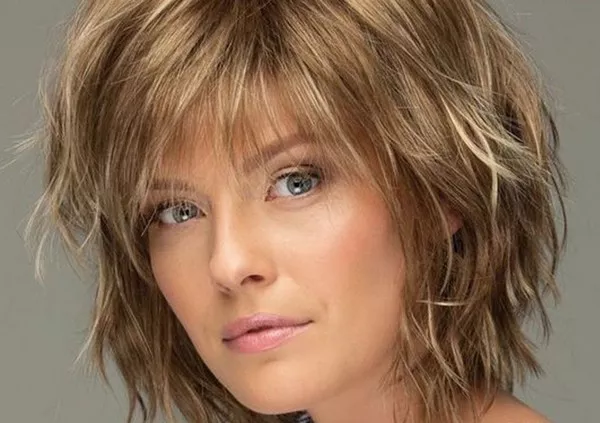Understanding the Difference and Choosing the Right Look
When it comes to hairstyling, a simple change in your bangs or fringe can completely transform your appearance. These face-framing elements can enhance your features, balance your facial shape, and add a touch of flair to your overall look. However, the terms “fringe” and “bangs” are often used interchangeably, leading to confusion among many people. In this article, we will clarify the difference between fringe and bangs, explore their history and cultural significance, and offer tips on how to choose the perfect style to suit your face shape and personal preferences.
1. Fringe: A Fashionable History
1.1 The Origins of Fringe
The term “fringe” has its origins in British English, and it refers to the hair that lies flat on the forehead, typically cut in a straight line. This style gained popularity in the 1920s during the flapper era, when women embraced the liberated spirit and desired a bold, avant-garde look. The fringe hairstyle became synonymous with the rebellious and daring nature of the time, often accompanied by shorter hairstyles or bobs.
1.2 The Versatility of Fringe
One of the key features of a fringe is its versatility. There are various fringe styles to choose from, ranging from blunt-cut fringes to side-swept or wispy fringes. The length and thickness of the fringe can also be adjusted to suit different face shapes and hair textures.
2. Bangs: A Timeless Classic
2.1 The Evolution of Bangs
The term “bangs,” on the other hand, is predominantly used in American English and is derived from the phrase “bang-off,” which refers to cutting hair straight across the forehead. The popularity of bangs dates back to the 1950s, where they were commonly seen on Hollywood icons such as Audrey Hepburn and Bettie Page. The style quickly became a timeless classic, often associated with elegance and femininity.
2.2 Bangs Across Cultures
The allure of bangs extends beyond Western culture, with many Asian countries embracing various bang styles throughout history. In Japan, for instance, the traditional “nihongami” often features a straight-across fringe, reflecting the country’s rich cultural heritage. Meanwhile, in South Korea, the “see-through” bangs have become a modern trend, emphasizing a softer, more natural look.
3. Fringe vs. Bangs: The Distinction
The primary distinction between fringe and bangs lies in the terminology, as both refer to the same basic concept of hair covering the forehead. However, the usage of the terms is influenced by regional language preferences and cultural context.
3.1 The Language Factor
In regions like the United Kingdom, Australia, and parts of Europe, “fringe” is the more commonly used term. British English speakers will refer to the hair covering the forehead as a fringe, whether it’s a straight-across cut or a side-swept style. On the other hand, American English speakers opt for “bangs” to describe the same concept, regardless of the specific style.
3.2 Cultural Significance
Beyond linguistic differences, the distinction between fringe and bangs can sometimes be rooted in cultural associations. As mentioned earlier, fringe gained popularity during the rebellious era of the 1920s in Britain, often linked to the flapper movement and its progressive ideals. On the contrary, bangs have been regarded as a more classic and timeless style, associated with Hollywood glamour and sophistication.
4. Choosing the Right Look: Factors to Consider
Deciding between fringe and bangs can be a challenging task, as it heavily relies on individual preferences and the shape of your face. Here are some factors to consider when making your choice:
4.1 Face Shape
Understanding your face shape is crucial in determining which style will complement your features best. For instance, if you have a round face, a long, side-swept fringe can help elongate your visage, while oval faces can carry off almost any fringe style with ease.
4.2 Hair Texture
Your hair’s natural texture plays a significant role in how your fringe or bangs will behave. Straight hair often works well with both fringe and bangs, while wavy or curly hair may require more maintenance to keep the style in shape.
4.3 Lifestyle and Maintenance
Consider the amount of time and effort you’re willing to invest in styling and maintaining your fringe or bangs. Some styles may require frequent trims to keep them at the desired length, while others might be more low-maintenance.
4.4 Regrowth and Commitment
Keep in mind that once you commit to a fringe or bangs, there will be a regrowth period if you decide to grow them out or change styles. Consider the long-term commitment before making your decision.
5. Popular Fringe and Bangs Styles
5.1 Classic Straight Fringe
A classic straight fringe is a bold statement that frames the forehead in a horizontal line. It works well for a variety of face shapes, adding a touch of sophistication and drama to your look.
5.2 Side-Swept Bangs
Side-swept bangs are versatile and flattering for many face shapes. Sweeping diagonally across the forehead, this style adds a soft and romantic touch to your appearance.
5.3 Wispy Fringe
Wispy fringes feature softer, feathered edges, providing a more delicate and effortless look. This style is ideal for those seeking a more relaxed and casual vibe.
5.4 Curtain Bangs
Curtain bangs, also known as Bardot bangs, are longer bangs parted in the middle and slightly tapered towards the ends. This retro-inspired style adds a chic, bohemian flair to your overall look.
Conclusion
In conclusion, understanding the difference between fringe and bangs is essential for effective communication with your hairstylist and finding the right style that complements your facial features and personal style. Whether you opt for the bold, edgy fringe or the timeless elegance of bangs, both options offer endless possibilities to elevate your look and make a statement with your hairstyle. Embrace the versatility and creativity that these face-framing elements offer, and let your hair become a canvas for self-expression and confidence. Remember, a well-chosen fringe or bangs can be the perfect finishing touch to any hairstyle, helping you look and feel your best every day.

